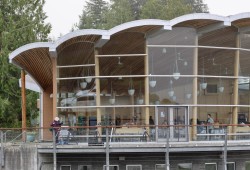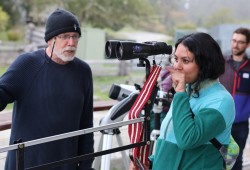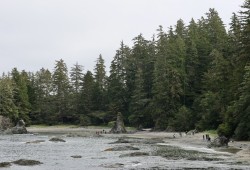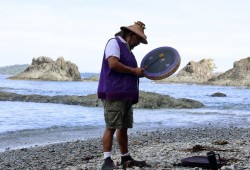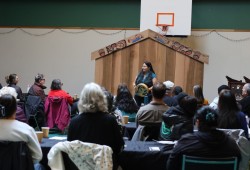Standing in the home of his ancestors at Kiixin (pronounced kee-hin), Huu-ay-aht’s ancient summer village site, knowledge keeper Qiic Qiica spoke about connection.
“That’s one of the most beautiful things about being Indigenous is our connectedness. We are not above or below anything in the world. We are a part of it,” said Qiic Qiica, a cultural interpreter for Kiix̣in Tours.
“We are deeply connected to everything around us. Not just the land or the ocean, but it’s also the cosmos. Our people were so connected to the cosmos, it’s only with our modern technology and conveniences that we have become disconnected,” said Qiic Qiica as he led a group of scientists, Indigenous leaders, tourism delegates, economic development partners, journalists and professional stargazers on a journey through time.
Under ancient skies, the group walked the shores at Kiixin to “where the mossy pillars of a long-ago archway are angled to mirror the three stars of the Big Dipper”, and Qiic Qiica revealed the legacy of Huu-ay-aht’s three stars – “Where have I been, where am I now and where do I want to be in the future.”
The group of about 30 gathered from Sept. 17 to 19 to experience the inaugural Three Stars Dark Sky Festival, a pilot project hosted by Huu-ay-aht First Nation (HFN), the Huu-ay-aht Group of Businesses and Foundry Events. The invite-only festival served as a preliminary guide to determine the feasibility of hosting a yearly public event anchored to the cosmos.
The First Nation intends to use the event to assess if it should apply to the Royal Astronomical Society of Canada (RASC) to become an official Dark-Sky Preserve. Inspired by the Jasper Dark Sky Festival, in Jasper, Alberta, HFN says a Dark-Sky project has the potential to expand its shoulder tourism season and “create a sustainable, educational, eco-friendly, and Indigenous-led tourism product while blending both scientific and Indigenous perspectives of the sky”.
HFN councillor Stella Peters thinks becoming a Dark-Sky Preserve would be a positive move for the nation and the Bamfield community.
“I think this is a good opportunity. Pachena Bay, Brady’s Beach, Kiixin, the beach before Kiixin Second Beach, Outer Shores… Those are all ideal locations where you could see a lot of stars and also for sunsets,” said Peters from the Rix Centre for Ocean Discoveries, Bamfield’s breathtaking conference centre that overlooks Barkley Sound.
RASC member and amateur astronomer Bill Weir set up his telescopes on the Rix Centre observation deck with the hopes of introducing guests to the night sky, but sadly was foiled by an overcast night.
“I have always looked up at the sky from being a little kid. I didn’t grow up in a big city, I grew up in a small town and not very far out a blanket of stars. I’ve always enjoyed looking up at it. I like looking for things. I really enjoy showing people the day and the night sky. I just like sharing joy,” said Weir.
On behalf of RASC, Weir gifted HFN an entry-level scope and book called ‘NightWatch: A Practical Guide to Viewing the Universe’ by Terence Dickinson. He went on to express his support to the nation for their commitment to preserving the night sky.
“This place is very similar to Jasper and the Grasslands, which both have the designation because there is so much darkness around it,” said Weir.
What is a Dark-Sky Preserve?
There are currently 26 Dark-Sky Preserves in Canada, according to RASC. Areas with a Dark-Sky Preserve designation are required to limit and strictly control artificial lighting while actively promoting and educating the reduction of light pollution.
“There are a bunch of hoops you have to jump through. It can be a long process,” notes Weir.
The Ha-Shilth-Sa sent a message to RASC requesting more information and will update this article when more details come in.
Astro photographer Jeanine Holowatuik travelled from Northern Saskatchewan to experience the Three Stars Dark Sky Festival and HFN traditional culture.
“Nothing shines brighter than a -40C night,” said Holowatuik during an inspiring slide show presentation of her night photography.
“The night sky is getting harder to find. Light polluted areas are one of the biggest problems no one is talking about,” she said continued.
Holowatuik showed the group an interactive website called lighpollutionmap.info that maps light pollution around the world with NASA infrared imagery.
“Eighty per cent of the world’s population live under polluted night skies. Satellites are changing the night sky,” said Holowatuik.
The Union of Concerned Scientists keeps a database of all satellites deployed. It’s latest update from January 2024 shows 7,561 satellites orbiting the Earth, with 3,995 of those satellites belonging to Elon Musk’s Starlink.
The number of satellites launched into orbit began to increase at an exponential rate, from 210 (2013), to 600 (2019), to 1,200 (2020) and to 2,470 in 2022, according to a recent report by the United Nations (UN) called For All Humanity – the Future of Outer Space Governance.
With the Three Stars Dark Sky project, HFN aims to promote and prioritize light pollution reduction. HFN's Sacred Principles, including ʔiisaak (Greater Respect), ʔuuʔałuk (Taking Care Of), and Hišuk ma c̕awak (Everything is One), are central to the project and seeking the Dark-Sky Preserve designation.
“It is a collective initiative involving the community, its people, and traditional knowledge through storytelling. This sustainable, eco-friendly, and educational initiative aims to boost the local economy for present and future generations while preserving resources provided by the land and natural world,” HFN said.
Huu-ay-aht language warrior Hinatinyis shared the word “t̓at̓uus”, which means “star” in Nuu-chah-nulth language. The sound of the ‘t̓’ is explosive, Hinatinyis explained.
“Barkley dialect sounds a lot like water rushing across the rocks, back and forth, back and forth,” said Hinatinyis from the House of Huu-ay-aht.
And like Qiic Qiica, she connected the wonders of the sky to the magic of the sea by conjuring up imagery of bioluminescent phytoplankton sparkling in the water like a starry midsummer night.


